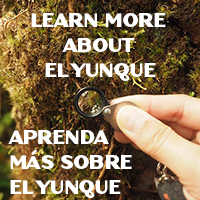Richmond’s Coqui
Richmonds Robber Frog, Richmond's Coqui, Ground Frog, Caoba Coqui (Eng.), Coquí Caoba (Sp.), Eleutherodactylus richmondi (Sci.), endemic endangered species, Puerto Rico.
Photo The Amphibians and Reptiles of Puerto Rico, Juan A. Rivero. Information compiled by Alan Mowbray, Interpretive Media Writer, EYNF/LEF
General Information
Taxonomy: Class – Amphibia (Amphibians), Order – Anura (Frogs), Family – Leptodactylidae (Leptodactylids), Genus – Eleutherodactylus, Species – E. Richmondi. This species is endemic to Puerto Rico’s subtropical or tropical moist mountains and lowlands – Note: The International Union for the Conservation of Nature (IUCN) red list cites this species as critically endangered with its population in decline. The species “type” was first identified and collected at an elevation of 890 feet (271 meters) on the “Eastern slope of El Yunque, Luquillo Experimental Forest” near the Catalina plantation, in what is now the El Yunque National Forest.
Description
Richmond’s Robber Frog is easily recognized. It is one of the larger coqui frogs, measuring 1.4 to 1.8 inches (35 to 46 millimeters), snout to vent. Because it is primarily terrestrial, its toe disks are smaller than those of many other coquis.
E. Richmondi’s basic coloring is deep or moderate reddish-brown (its color is said to resemble mahogany; hence the Spanish name “Coquí Caoba – Mahogany Coqui) with a yellowish-white line on each side of the back from snout tip almost to vent. Broad dark bands are seen on each side with a series of dark spots below. The backs of the thighs are typically spotted.
Habits
E. Richmondi is one of the most terrestrial (ground dwelling) of the coquis. It is seldom seen on tree leaves; when it is, the leaves are usually no more than 2 to 3 feet (0.6 to 0.9 meters) above the ground. A nocturnal animal, it hides under roots, logs and rocks during the day. Its voice is typically a one note “Tic,” or occasionally a few sequential notes (CLICK HERE for recorded sound). The sequential notes are more prevalent at higher altitudes. E. richmondi is more active during the winter months when its voice is most often heard. Females lay a clutch of eggs, under a rotten, fallen log. The egg clutch is typically guarded by the male until the eggs have hatched.
Habitat
Found above 600 feet (183 meters) elevation in El Yunque’s tropical and sub-tropical montane forest.
Threats
The population of E. richmondi has been reduced significantly in recent years for undetermined reasons. A parasitic nematode of the genus Aplectana has been reported to have been found in the stomach of this species.
Where to look for this animal in the EYNF
Although the population of this species is dwindling (see “Threats” above), it can occasionally be viewed in the daytime hours during winter months by looking carefully under logs, roots or rocks, in brushy areas near the Big Tree, Caimitillo, Baño de Oro, La Mina and Mt. Britton nature trails.
Additional Information
Biologist
USDA Forest Service
El Yunque National Forest
HC-01 Box 13490
Rio Grande, PR 00745
787 888 1810
| Richmond's Coqui | Orange-Fronted Parakeet | Puerto Rican Galliwasp |
|---|---|---|
| Tree Snail | Puerto Rican Crested Anole | Puerto Rican Flycatcher |
| Puerto Rican Wetlands Blindsnake | Fathead Minnow | Yellow-Bellied Sapsucker |
| Antillean Ghost-Faced Bat | Adelaide's Warbler | Green Swordtail |



